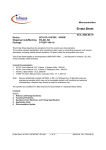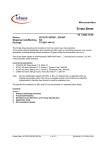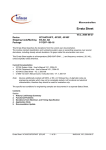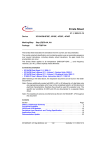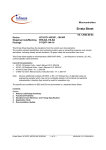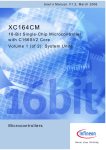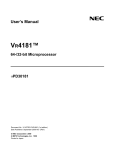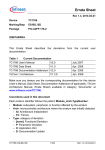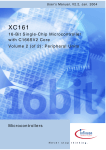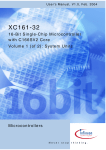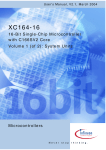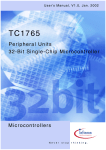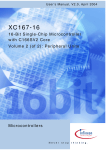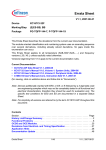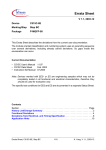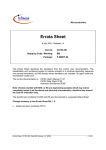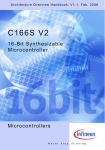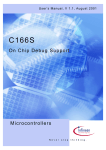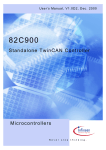Download Errata Sheet
Transcript
Microcontrollers Errata Sheet __________________________________________________________ V0.1, 2004-08-19 Device Stepping Code/Marking Package XC164CS-32F20F, -32F40F BA P-TQFP-100-16 This Errata Sheet describes the deviations from the current user documentation. The module oriented classification and numbering system uses an ascending sequence over several derivatives, including already solved deviations. So gaps inside this enumeration can occur. This Errata Sheet applies to all temperature (SAB-/SAF-/SAK-.....) and frequency versions (.20./.40.), unless explicitly noted otherwise. Current Documentation • XC164CS-32F Data Sheet – V1.0BA, 2004-05 • specific modifications/enhancements of -32F version XC164-32F Target Specification V1.1, 2003-01 • • • basic features of XC164: XC164-16 User's Manual V2.1, Volume 1: System Units – 2004-03 XC164-16 User's Manual V2.1, Volume 2: Peripheral Units – 2004-03 C166S V2 User's Manual (Core, Instruction Set) - V1.7, 2001-01 Note: Devices additionally marked with EES- or ES- or E followed by a 3-digit date code are engineering samples which may not be completely tested in all functional and electrical characteristics, therefore they should be used for evaluation only. The specific test conditions for EES and ES are documented in a separate Status Sheet. Contents Section 1. History List/Change Summary 2. Functional Problems 3. Deviations from Electrical- and Timing Specification 4. Application Hints 5. Documentation Update Errata Sheet XC164CS-32F20F/40F BA - 1 of 18 – Mh/Es/UK, V0.1, 2004-08-19 1. History List/Change Summary from Errata Sheet Rev. 0.1 for XC164CS-32F devices with marking (E)ES-BA to this Errata Sheet Rev. 0.1 for XC164CS-32F devices with marking BA: The following problem has been fixed: - Reset while PLL is not locked (SCU_X.010) Description of the following problems added: - Frequency Limits for Flash Read Accesses (FCPUR_X.162832.1): see section “Deviations from DC/AC Specification” - ASC Autobaud Detection in 8-bit Modes with Parity (ASC_X.001) Description of the following problems modified: - PACER trap after wake-up from Sleep/Idle mode (FLASH_X.004): Workaround4 added Description of the following Application Hints modified: - Clock system after wake-up from Sleep Mode (SLEEP_X.H3.2 – replaces SLEEP_X.H3.1) - Power Consumption during Clock System Configuration (POWER_X.H2.2 – replaces POWER_X.H2.1) The following Application Hint has been removed: - Using the Bootstrap Loader over a Single-Wire Connection (BSL_X.H1.1): covered by User’s Manual Errata Sheet XC164CS-32F20F/40F BA - 2 of 18 – Mh/Es/UK, V0.1, 2004-08-19 1.1 Summary of Fixed Problems Problem Name Short Description Fixed in Step SCU_X.010 Reset while PLL is not locked (step (E)ES-BA only) BA 1.2 Summary of Open Problems Problem Name Short Description Remarks EBC_X.003 CPU_X.002 TwinCAN2.007 TwinCAN2.008 TwinCAN2.009 FLASH_X.004 ASC_X.001 OCDS_X.002 TwinCAN access with EBC enabled Branch to wrong target after mispredicted JMPI Transmit after error Double remote request CPUUPD remote PACER trap after wake-up from Sleep/Idle mode ASC Autobaud Detection in 8-bit Modes with Parity OCDS indicates incorrect status after break_now requests if PSW.ILVL ≥ CMCTR.LEVEL OCE_X.001 Wrong MAC Flags are declared valid at Core - OCE interface FCPUR_X.162832.1 Frequency Limits for Flash Read Accesses 1.3 Summary of Application Hints Name Short Description CPU_X.H1 CPU_X.H2 FLASH_X.H1.1 FLASH_X.H2.2 FLASH_X.H3.1 FLASH_X.H4 SLEEP_X.H3.2 IDLE_X.H1 ADC_X.H1 BREAK_X.H1 POWER_X.H1.1 POWER_X.H2.2 RSTOUT_X.H1 SCU_X.H1 SCU_X.H2.1 SCU_X.H3 SCU_X.H4 SCU_X.H5 RTC_X.H1.2 FOCON_X.H1 Configuration of Registers CPUCON1 and CPUCON2 Special Characteristics of I/O Areas Access to Flash Module after Program/Erase Access to Flash Module after Shut-Down Read Access to internal Flash Module with modified Margin Level Minimum active time after wake-up from sleep or idle mode Clock system after wake-up from Sleep Mode Entering Idle Mode after Flash Program/Erase Polling of Bit ADBSY Break on MUL/DIV followed by zero-cycle jump Initialization of SYSCON3 for Power Saving Modes Power Consumption during Clock System Configuration RSTOUT# driven by weak driver during HW Reset Shutdown handshake by software reset (SRST) instruction Preservation of internal RAM contents after reset Effect of PLLODIV on Duty Cycle of CLKOUT Changing PLLCON in Emergency Mode Sleep/Idle/Power Down Mode not entered while PLLODIV = 0Fh Resetting and Disabling of the Real Time Clock Read Access to register FOCON Errata Sheet XC164CS-32F20F/40F BA Remarks - 3 of 18 – Mh/Es/UK, V0.1, 2004-08-19 2. Functional Problems EBC_X.003 TwinCAN Access with EBC enabled If the External Bus Controller (EBC) is enabled, a read or write access to the TwinCAN module fails when an external bus access with TCONCSx.PHA ≠ 00b precedes the TwinCAN access. Workaround: Since it is hard to predict the order of external bus and TwinCAN accesses (in particular when PEC transfers are involved), it is recommended to set bitfield PHA to '00' in all TCONCSx registers which are used for external bus accesses. CPU_X.002 Branch to wrong target after mispredicted JMPI After a JMPI is initially mispredicted according to the static branch prediction scheme of the C166S V2, code execution may continue at a wrong target address in the following situations: Situation I: a memory write operation is processed by the DMU followed by a MUL(U) followed by the mispredicted JMPI Example_1: MOV mem, [Rwn] MUL R13, R14 JMPI cc_NV, [R6] Situation II: MUL(U) or DIV(L/U/LU) followed by not-mispredicted zero-cycle jump (e.g. JMPA, JMPR, JMPS; bit CPUCON1.ZCJ = 1) followed by the mispredicted JMPI - Example_2a: MULU R13, R14 JMPA- cc_V, _some_target JMPI cc_NV, [R6] ; predicated not taken => correct ; taken, but predicted not taken It could be possible that the JMPI is at the jump target of the JMPA, if it is taken: Example_2b: MULU R13, R14 JMPA+ cc_NZ, _jmpi_addr ..... other code .... _jmpi_addr: JMPI cc_NV, [R6] ; predicted taken => correct ; taken but predicted not taken Effect on tools: In the Altium/Tasking compiler (v7.0 and above) the problem is not present. The result of a MUL/DIV instruction is available through the MDL/MDH SFRs. These SFRs are not allocatable by the register allocator. Therefore, the compiler always needs a MOV instruction to transfer MDL/H to a GPR. This avoids the problem. In the RT- and FP-libraries (v7.0 and above) the problem was not found. Versions lower than v7.0 do not explicitly support the C166S V2 core. In case optimizations are implemented in future versions which could cause this problem to occur, also a workaround will be included. Errata Sheet XC164CS-32F20F/40F BA - 4 of 18 – Mh/Es/UK, V0.1, 2004-08-19 All Keil C166 tool Versions (compiler and libraries) since V3.xx do not generate a MUL(U) or a DIV(L/U/LU) followed by either of the jump instructions JMPR, JMPS, JMPA, JMPI. Basically the support of the C166S V2 core requires anyway V4.21 or higher. Workarounds (e.g. for program parts written in assembly language): - generally disable overrun of pipeline bubbles by clearing bit CPUCON2.OVRUN (CPUCON2.4 = 0). This will result only in a negligible performance decrease, and will prohibit corruption of the target IP of the JMPI. or: - provide a NOP (or any other suitable instruction) between the MUL/DIV instructions and the succeeding jump in the above cases. To simplify, place a NOP between any MUL/DIV and a JMPR, JMPS, JMPA, JMPI that might follow it. Other branches (CALLs, jump-on-bit instructions) do not need to be taken into account. TwinCAN2.007 Transmit after Error During a CAN error, transmission may stop (after EOF or an error frame), until a successful reception or a write access to the TwinCAN module. Detailed Description In case of a CAN error and there is no other activity on the CAN module (e.g. frame reception / frame transmission on the other CAN node / write access to any CAN register), the transmission of messages may stop, even if some transmit requests are still set. The CAN module will start transmitting immediately, after a reception or a write access to the module. Workarounds a) Write periodically 0xFFFF to one of the MSGCTRx registers, as this value is having no effect on the register. b) In case writing to a CAN register shall be the exception, use the last error code (LEC) interrupt. This shall start writing to one of the MSGCTRx register 0xFFFF, in case the LEC value is unequal to 0. TwinCAN2.008 Double remote request After the transmission of the remote request, TXRQ is not cleared in the receive object, if NEWDAT is set. As a consequence the remote request is transmitted once again. Workaround: Clear NEWDAT after the reception of a data frame. TwinCAN2.009: CPUUPD remote In case of a remote request to a standard message object which is chosen for transmission, a transmit of the data frame takes place, even if CPUUPD is currently set. Detailed Description If a transmit message object gets a remote request and there is no other message object with higher transmit priority pending for transmission, then the transmit object sends the data frame to answer the remote request, even if CPUUPD is set. Errata Sheet XC164CS-32F20F/40F BA - 5 of 18 – Mh/Es/UK, V0.1, 2004-08-19 Workaround This workaround is only required in systems where remote requests are used. To answer remote requests, the MMC bitfield in MSGFGCR has to be configured to a FIFO slave object instead of a standard message object for transmission. To reach this goal, the following settings for the corresponding message object are needed: • MSGFGCRn.MMC := (011)b FIFO slave object • MSGFGCRn.CANPTR := n shall reference itself, by referring to the message object number of this object. • MSGFGCRn.FD := 0 FLASH_X.004 PACER Trap after Wake-Up from Sleep/Idle Mode An unexpected Program Access Error Trap (flag PACER = 1 in register TFR) occurs after a wake-up event from sleep or idle mode under the following conditions: - bit field PFCFG = 01b in register SYSCON1, i.e. the flash module is switched off during sleep or idle mode - a wake-up event (interrupt, PEC transfer, NMI#) occurs in a specific time window (few clock cycles) after execution of the IDLE instruction during the flash deactivation process - and the corresponding interrupt/trap routine or the instruction following IDLE (in case interrupts are disabled) or the PEC source data are located in the internal flash. Workaround 1 Do not switch off the flash module in sleep or idle mode, i.e. leave bit field PFCFG = 00b in register SYSCON1 (default after reset). This increases power consumption to a certain extent while reducing the time overhead for sleep/idle mode entry and exit (in clocking modes where the clock is derived from the VCO). Workaround 2 In order to avoid the problem (when PFCFG = 01), make sure that the wake-up trigger only occurs after the device has completely entered sleep or idle mode. If the RTC is used as wake-up source, check e.g. the RTC before entering sleep mode. If the wake-up trigger will occur soon, either skip entry into sleep mode, or extend the time for the next wake-up. If the RTC time interval is reprogrammed, make sure that no interrupt occurs between reprogramming and entry into sleep mode. Workaround 3 In order to differentiate an unexpected PACER trap due to a wake-up trigger in the critical time window from other events that can lead to a PACER trap, set a semaphore bit before executing the IDLE instruction., e.g. ATOMIC #2 BSET sema_idle IDLE In the trap handler for the PACER trap, if the semaphore bit is set and no other indications for the PACER trap are found (e.g. error flags in register FSR are set), clear the semaphore bit and the PACER flag and return from the trap handler with RETI. The stack contains a valid return address in this case (e.g. address of instruction following IDLE in case interrupts were disabled during wake-up). For PEC transfers during sleep or idle mode, which will cause a PACER trap if they read data from flash, automatic return to sleep/idle mode is not accomplished with the concept described so far. Errata Sheet XC164CS-32F20F/40F BA - 6 of 18 – Mh/Es/UK, V0.1, 2004-08-19 In order to support return to idle/sleep mode after a PEC transfer (which is performed after the RETI instruction from the PACER trap routine is executed), e.g. a semaphore bit may be used. This bit may be set to ‘1’ before the IDLE instruction is executed. All trap (except PACER) and interrupt service routines invoked after wake up from idle/sleep should clear this bit to ‘0’. After having returned from the PACER trap routine to the program in the internal flash, this bit should be tested (allow a sufficient time of e.g. 12 cycles for interrupt arbitration), and if it is still at ‘1’ (i.e. no interrupts/traps have occurred), repeat the IDLE instruction for re-entry into idle/sleep mode. Workaround 4 Use an auxiliary sequence in internal PRAM that bridges the time until the flash is ready after wake-up from sleep/idle mode, e.g.: - Disable interrupts, and execute the IDLE instruction to enter sleep mode from the internal PRAM. After wake-up, the instruction following IDLE will be executed (if no hardware trap or NMI# has occurred). - Wait until the internal flash is ready after wake-up (check register FSR) before reading from the internal flash). If the sequence in internal PRAM that includes the IDLE instruction is not CALLed from internal flash (i.e. it is not terminated with a RETx instruction), at least 8 instructions that do not read from the internal flash should be inserted after the IDLE instruction to avoid speculative prefetches - Enable the interrupt system again. The following details should be considered: - If hardware traps (including NMI#) can occur, add the corresponding interrupt vectors to PRAM and modify register VECSEG to point to the PRAM space. - In order to support return to idle/sleep mode after a PEC transfer, e.g. a semaphore bit may be used. This bit may be set to ‘1’ before the IDLE instruction is executed. All trap and interrupt service routines invoked after wake up from idle/sleep should clear this bit to ‘0’. After having returned to the program in the internal flash and having enabled the interrupt system, this bit should be tested (allow a sufficient time of e.g. 12 cycles for interrupt arbitration), and if it is still at ‘1’ (i.e. no interrupts/traps have occurred), repeat the auxiliary routine that prepares for re-entry into idle/sleep mode. ASC_X.001 ASC Autobaud Detection in 8-bit Modes with Parity The Autobaud Detection feature of the Asynchronous/Synchronous Serial Interface (ASC) does not work correctly for 8-bit modes with even or odd parity. The Autobaud Detection feature works correctly for 7-bit modes with even or odd parity, and for 8-bit modes without parity. Errata Sheet XC164CS-32F20F/40F BA - 7 of 18 – Mh/Es/UK, V0.1, 2004-08-19 Items in OCDS and OCE Modules The following issues have been found in the OCDS and OCE modules. Please see the debugger or emulator manufacturer's documentation whether or not these issues actually cause a problem or restriction when the respective tool is used. OCDS_X.002 OCDS indicates incorrect status after break_now requests if PSW.ILVL ≥ CMCTR.LEVEL When the OCDS processes a break_now request while the CPU priority level (in PSW.ILVL) is not lower than the OCDS break level (in CMCTR.LEVEL), the actual break is delayed until either PSW.ILVL or CMCTR.LEVEL is reprogrammed such that CMCTR.LEVEL > PSW.ILVL. If in the meantime further debug events have occurred, register DBGSR will still indicate the status of the first break_now request. If e.g. a software break is executed, the OCDS will accept this, but register DBGSR will indicate the wrong cause of break. Workarounds: 1. If the application uses tasks with different levels and debugging is to take place using the OCDS break level feature (e.g. only tasks up to a maximum level are halted, higher-level tasks aren't halted, and the OCDS level is programmed in between), there is no problem if: - only classic hardware breakpoints (IP address) or software breakpoints are used (i.e. no trigger on address, data, TASKID) - no external pin assertions are used to trigger breaks - no direct writes to DBGSR.DEBUG_STATE are used to force breaks 2. If break_now request sources are to be used, the maximum level of the application (PSW.ILVL) should always be lower than the programmed OCDS break level (e.g. PSW.ILVL ≤ 14d, CMCTR.LEVEL = 15d). This means that all generated break_now requests by the OCDS will always be accepted, independent of the CPU / interrupt priority. OCE_X.001 Wrong MAC Flags are declared valid at Core - OCE interface In case a MAC instruction (Co...) is directly followed by a MOV MSW, #data16 instruction, the upper byte of data16 is output instead of the flags corresponding to the MAC instruction. The bug was found with code: coshr #00001h mov MSW, #00100h (+ other variations of data16) Workaround: Add a NOP between the two instructions: coshr #00001h nop mov MSW, #00100h (+ other variations of data16) Errata Sheet XC164CS-32F20F/40F BA - 8 of 18 – Mh/Es/UK, V0.1, 2004-08-19 3. Deviations from Electrical and Timing Specification Reference: XC164CS-32F Data Sheet – V1.0BA, 2004-05 (for (E)ES devices, see also Status Sheet) The following restrictions should be considered: FCPUR_X.162832.1 Frequency Limits for Flash Read Accesses For instruction and data read accesses to the internal flash module (including programming and erase sequences), and after a hardware, software, or watchdog timer reset, the frequency limits listed below must be considered, otherwise instructions and operands read from the internal flash may become incorrect. The problem depends primarily on the internal frequency fCPU and the number of wait states selected for the flash module (bit field WSFLASH in register IMBCTR). It is statistically more likely to occur when the ambient temperature TA is in the upper region of the specified range, and when the internal supply voltage VDDI is in the lower region of the specified range. When the problem occurs during program execution, this typically results in a class B trap (program access error, indicated by flag PACER = 1 in register TFR), while the flash status register FSR signals single or double bit errors. For applications that exceed a specific frequency limit at a given maximum ambient temperature TA, an additional wait state for the flash module will avoid the problem during program execution as listed in the tables below. No problem will occur in applications that use the following settings and limits: a) Ambient Temperature -40 °C ≤ TA ≤ 85 °C fCPU Number of wait states for flash module Special Consideration for Reset fCPU ≤ 16 MHz 0 WS (WSFLASH = 00b) 1 WS (WSFLASH = 01b) default after reset 2 WS (WSFLASH = 10b) not required 16 MHz < fCPU ≤ 32 MHz fCPU > 32 MHz not required required, see below b) Ambient Temperature TA > 85 °C fCPU Number of wait states for flash module Special Consideration for Reset fCPU ≤ 16 MHz 0 WS (WSFLASH = 00b) 1 WS (WSFLASH = 01b) default after reset 2 WS (WSFLASH = 10b) not required 16 MHz < fCPU ≤ 28 MHz fCPU > 28 MHz not required required, see below Note: fCPU(max) = 40 MHz for devices marked .40F, and fCPU(max) = 20 MHz for devices marked .20F. Errata Sheet XC164CS-32F20F/40F BA - 9 of 18 – Mh/Es/UK, V0.1, 2004-08-19 The performance decrease due to an additional wait state depends on the individual characteristics of the software. Due to the internal instruction prefetch queue, the average performance decrease when using 1 wait state instead of 0 wait states is expected to be approximately 5%, and approximately 15% when using 2 wait states instead of 1 wait state. Special Considerations for Reset and fCPU > 28 MHz (TA > 85 °C) or fCPU > 32 MHz (TA < 85 °C) For a hardware reset in external bus mode (pin EA# = low), select a start-up configuration on PORT0 that results in fCPU ≤ 28 MHz (for TA > 85 °C), or fCPU ≤ 32 MHz (for TA < 85 °C), respectively. The desired target frequency may then be selected via software by reconfiguring register PLLCON. Before performing a software reset, reprogram register PLLCON to a value that results in fCPU ≤ 28 MHz (for TA > 85 °C), or fCPU ≤ 32 MHz (for TA < 85 °C), respectively. For applications using a watchdog timer reset, there is an additional risk that the code executed from flash may fail after a watchdog timer reset has occurred while the external oscillator is not (yet) locked (indicated by bit OSCLOCK = 0 in register SYSSTAT). This is in particular the case if a watchdog timer reset occurs after wake-up from sleep mode when the external oscillator was switched off (i.e. RTC not running on frequency derived from XTAL1). In this case, either disable the watchdog timer, or select a watchdog time interval that is long enough to cover the oscillator start-up and lock time. This is typically about 6 ms for a 4 MHz crystal, and about 1 ms for a 16 MHz crystal. Errata Sheet XC164CS-32F20F/40F BA - 10 of 18 – Mh/Es/UK, V0.1, 2004-08-19 4. Application Hints CPU_X.H1 Configuration of Registers CPUCON1 and CPUCON2 The default values of registers CPUCON1 and CPUCON2 have been chosen to provide optimized performance directly after reset. It is recommended - not to modify the performance related parts (3 LSBs) of register CPUCON1 - not to modify register CPUCON2, except for test purposes or for enabling specific workarounds under special conditions (see e.g. problem CPU_X.002 or application hint BREAK_X.H1). CPUCON2: reset/recommended value = 8FBBh CPUCON1: reset/recommended value = 0..0 0XXX X111; only the 3 lsbs are performance related Bit Position Field Name CPUCON1.[15:7] 0 CPUCON1.[6:5] VECSC Value Description 0 00 CPUCON1.4 WDTCTL 0 CPUCON1.3 SGTDIS 0 CPUCON1.2 CPUCON1.1 CPUCON1.0 INTSCXT BP ZCJ 1 1 1 CPU_X.H2 ; enables several performance features reserved scaling factor for vector table, value depends on application, '00' is compatible to C166 systems configuration for scope and function of DISWDT/ENWDT instructions, value depends on application, '0' is compatible to C166 systems segmentation enable/disable control, value depends on application enable interruptibility of switch context enable branch prediction unit enable zero cycle jump function Special Characteristics of I/O Areas As an element of performance optimization, the pipeline of the C166S V2 core may perform speculative read accesses under specific conditions. In case the prediction for the speculative read was wrong, the read to the actually required location is restarted. While this method is uncritical e.g. for accesses to non-volatile memories or SRAMs, it may cause problems on devices which do not tolerate speculative reads (e.g. FIFOs which are advanced on every read access). No speculative reads are performed in memory areas which are marked as I/O area. This memory area includes - the SFR and ESFR space (e.g. with buffers for received data from serial interfaces or A/D results) - the 4 Kbyte internal I/O area (00'E000h..00'EFFFh), including IIC and SDLM module on XC161 - the 2 Mbyte external I/O area (20'0000h..3F'FFFFh), including the TwinCAN module (default: from 20'0000h .. 20'07FFh) It is therefore recommended to map devices which do not tolerate speculative reads into the 2 Mbyte external I/O area (20'0000h..3F'FFFFh). For further special properties of the I/O areas, see p.3-13 in the XC164 User's Manual V2.0, Volume System Units 2003-03. FLASH_X.H1.1 Access to Flash Module after Program/Erase After the last instruction of a program or erase command, the BUSY bit in register FSR is set to '1' (status = busy) after a delay of one instruction cycle. When polling the BUSY flag, one NOP or other instruction which is not evaluating the BUSY flag must be inserted after the last instruction of a program or erase command. Errata Sheet XC164CS-32F20F/40F BA - 11 of 18 – Mh/Es/UK, V0.1, 2004-08-19 No additional delay is required when performing the first operand read or instruction fetch access from the flash module after the BUSY bit has returned to '0' (status = not busy). FLASH_X.H2.2 Access to Flash Module after Shut-Down When the flash is disabled by software (shut-down) by writing bit PFMDIS = 1 in register SYSCON3, - and it is (at some later time) enabled again by writing PFMDIS = 0 - and the instruction immediately following the instruction which sets PFMDIS = 0 is fetched or reads operands from internal flash then the PACER flag in register TFR is set and the BTRAP routine is entered. Therefore, it is recommended to insert 4 NOPs before the internal flash is accessed again after PFMDIS has been set to 0. FLASH_X.H3.1 Read Access to internal Flash Module with modified Margin Level 1. When the internal flash module is read (e.g. for test purposes) with bit field margin = 0001b (low level margin) in register MAR, an additional wait state must be used, i.e. - bit field WSFLASH in register IMBCTR must be set to 10b for fcpu > 20 MHz, - bit field WSFLASH in register IMBCTR must be 01b (default after HW reset) for fcpu < 20 MHz 2. When writing to the Margin Control Register MAR (with the Write Margin command), bit MAR.7 must be written as ‘1’. FLASH_X.H4 Minimum active time after wake-up from sleep or idle mode If the flash module is automatically disabled upon entry into sleep or idle mode (bit field PFCFG = 01b in register SYSCON1), sleep or idle mode should not be re-entered before a minimum active (“awake”) time has elapsed. Otherwise, the current consumption during this sleep/idle phase will be ~ 1 mA above the specified limits of the Data Sheet. Therefore, - If code is executed from the internal flash after wake-up, at least 16 instructions should be executed from the internal flash before re-entering sleep/idle mode. - If code is executed from external memory or PRAM, wait until the flash BUSY bit returns to ‘0’ before re-entering sleep/idle mode. - If PEC transfers with automatic return to sleep/idle mode shall be triggered by the wake-up event, use e.g. the following procedure: use an auxiliary routine in internal flash that waits until the flash is ready after wake-up from sleep or idle mode, e.g. - define a semaphore bit that is set to ‘1’ before the IDLE instruction is executed. All trap and interrupt service routines invoked after wake up from idle/sleep should clear this bit to ‘0’ - disable interrupts - execute the IDLE instruction - if idle or sleep mode is terminated by an interrupt request, the instructions following the IDLE instruction will be executed (the interrupt request flags remain set) - if idle or sleep mode was terminated by an NMI#, the trap handler will be invoked - enable interrupts to allow prioritization of requests for interrupt or PEC service - the instructions following the IDLE instruction should test the flash BUSY bit in register FSR when the flash is ready, and at least 12 instructions have been executed after the interrupt system has been enabled, and if the semaphore bit is still at ‘1’ (i.e. no interrupts/traps have occurred), disable interrupts and return to the IDLE instruction Errata Sheet XC164CS-32F20F/40F BA - 12 of 18 – Mh/Es/UK, V0.1, 2004-08-19 SLEEP_X.H3.2 Clock system after wake-up from Sleep Mode There are different wake-up behaviors, depending on the PLL control setting used in register PLLCON during entry into sleep mode, and depending on whether the RTC is running on the main oscillator. Note that in either case, the VCO is turned off during sleep mode, and does not contribute to any additional power consumption. • In bypass mode with VCO off (PLLCTRL = 00b), the device will directly continue to run on the frequency derived from the external oscillator input after wake-up from sleep. If the RTC is running on the main oscillator, the device is immediately clocked, since the oscillator (input XTAL1) is not turned off during sleep mode. If the RTC was not running on the main oscillator, the system will not be clocked until the amplitude on the external oscillator input XTAL1 exceeds the input hysteresis. This requires typ. a few ms, depending on external crystal/oscillator circuit. With this mode, there is no oscillator watchdog function, and the system will not be clocked until the external oscillator input XTAL1 receives a clock that exceeds the input hysteresis. • In bypass mode with VCO on (PLLCTRL = 01b), the device will directly continue to run on the frequency derived from the external oscillator input after wake-up from sleep if the RTC continues to run on the main oscillator in sleep mode. In case the PLL was locked before entry into sleep mode, emergency mode is entered. This results in PLLODIV = 0Fh and bit SYSSTAT.EM = 1. This change of configuration will not be notified by the PLL Unlock/OWD interrupt (flag PLLIR). This condition will remain until an external HW reset is applied, or a wake-up event from sleep mode with main oscillator off (i.e. RTC not running on main oscillator) occurs. If the RTC was not running on the main oscillator, (i.e. the main oscillator was off during sleep mode), the device will wake-up using the internal PLL base frequency from the VCO (fbase/16) and will temporarily stay in emergency mode (i.e. run on the frequency derived from the VCO) until bit OSCLOCK in register SYSSTAT gets set to 1. It is not possible to switch to direct drive (VCO bypass) mode within this timeframe. If bypass mode (PLLCTRL = 00b) is required by an application after wake-up from sleep, it is therefore recommended to switch to bypass mode already before entry into sleep mode (check PLLCON for its target value before executing the IDLE instruction to enter sleep mode). See also SCU_X.H5. • • In PLL mode with input clock from XTAL1 disconnected (PLLCTRL = 10b), the device will only wake up from sleep if the RTC was not running on the main oscillator (i.e. when the main oscillator is off during sleep mode). In this case, the device will run using the internal PLL base frequency from the VCO (fbase/16) until the amplitude on the external oscillator input XTAL1 exceeds the input hysteresis, and then switch to fbase/k with the output divider selected by PLLODIV. If the RTC is running on the main oscillator, the device will not wake-up from sleep mode with this PLLCTRL setting. It is therefore recommended to switch to bypass mode (PLLCTRL = 00b) before entry into sleep mode (check PLLCON for its target value before executing the IDLE instruction to enter sleep mode). In PLL mode with input clock from XTAL1 connected to the VCO (PLLCTRL = 11b), if the RTC was not running on the main oscillator, the device will wake-up in emergency mode and run using the internal PLL base frequency from the VCO (fbase/16) until the amplitude on the external oscillator input XTAL1 exceeds the input hysteresis. Then the PLL resynchronizes to the target frequency determined by the settings in register PLLCON. When bit OSCLOCK gets set in register SYSSTAT, the output divider PLLODIV will be set to the target value. If the RTC is running on the main oscillator, the device will wake-up and resynchronize to the target frequency determined by the settings in register PLLCON. Errata Sheet XC164CS-32F20F/40F BA - 13 of 18 – Mh/Es/UK, V0.1, 2004-08-19 In case the PLL was locked before entry into sleep mode, emergency mode is entered. This results in PLLODIV = 0Fh and bit SYSSTAT.EM = 1. This change of configuration will not be notified by the PLL Unlock/OWD interrupt (flag PLLIR). This condition will remain until an external HW reset is applied, or a wake-up event from sleep mode with main oscillator off (i.e. RTC not running on main oscillator) occurs. As an alternative, switch to bypass mode with VCO on and PLL unlocked before entering sleep mode (e.g. PLLCON = 2000h). After wake-up, PLLCON may be reconfigured to the desired PLL operating mode. IDLE_X.H1 Entering Idle Mode after Flash Program/Erase After a program/erase operation, idle mode should not be entered before the BUSY bit in register FSR has returned to '0' (status = not busy). ADC_X.H1 Polling of Bit ADBSY After an A/D conversion is started (standard conversion by setting bit ADST = 1, injected conversion by setting ADCRQ = 1), flag ADBSY is set 5 clock cycles later. When polling for the end of a conversion, it is therefore recommended to check e.g. the interrupt request flags ADC_CIC_IR (for standard conversions) or ADC_EIC_IR (for injected conversions) instead of ADBSY. BREAK_X.H1 Break on MUL/DIV followed by zero-cycle jump When a MUL or DIV instruction is immediately followed by a falsely predicted conditional zero-cycle jump (JMPR or JMPA on any condition other than cc_UC), and - either a 'break now' request is set at the time the MUL / DIV instruction is being executed (i.e. a break request on operand address, data, task ID, BRKIN# pin etc. is generated by one of the instructions (may be up to four) preceding MUL/DIV) - or a 'break-before-make' request (break on IP address) is derived from the instruction immediately following the jump (jump target or linear following address, depending whether the jump is taken or not ) then the internal program counter will be corrupted (equal to last value before jump), which will lead to a false update of the IP with the next instruction modifying the IP. This problem occurs for debugging with OCDS as well as with OCE. Note: The Tasking and Keil compilers (including libraries) do not generate this type of critical instruction sequence. Workarounds (choices): For assembler programmers, one of the following workarounds may be used (1) disable zero-cycle operation for jumps when debugging code (set CPUCON1.ZCJ to '0'), or (2) include a NOP after any MUL/DIV instruction followed by a conditional jump (JMPR, JMPA), or (3) do not set any 'break-before-make'-type breakpoints on the instruction following the jump, or 'break now'-type breakpoints shortly before or on the MUL / DIV instructions POWER_X.H1.1 Initialization of SYSCON3 for Power Saving Modes For minimum power consumption during power saving modes, all modules which are not required should be disabled in register SYSCON3, i.e. the corresponding disable bits should be set to '1', including bits which are marked as 'reserved' (this provides compatibility with future devices, since all Errata Sheet XC164CS-32F20F/40F BA - 14 of 18 – Mh/Es/UK, V0.1, 2004-08-19 SYSCON3 bits are disable bits). Reading these bits will return the written value, as for peripherals without shut-down handshake. For peripherals equipped with peripheral shut-down handshake, reading allows to check their shut-down status. POWER_X.H2.2 Power Consumption during Clock System Configuration In the following situations (1) after wake-up from sleep mode until oscillator lock in case the main oscillator was turned off during sleep mode (2) after a clock failure (PLL unlock or oscillator fail) until clock reconfiguration by software the device is internally clocked by the VCO running on the base frequency of the currently selected VCO band divided by 16. This results in an operating frequency range of 1.25 .. 11.25 MHz, depending on the currently selected VCO band. Systems designed for lower target frequencies should consider the increased power consumption due to the potential frequency increase during these phases of operation. Exception in bypass mode with VCO off: in case (1), if the RTC is not running on the main oscillator, and case in (2) the device stops until it again receives a clock from the oscillator. RSTOUT_X.H1 RSTOUT# driven by weak driver during HW Reset A weak driver (see specification in Data Sheet) has been implemented on pin RSTOUT# which is driven low while RSTIN# is asserted low. After the end of the internal reset sequence, RSTOUT# operates in default mode (strong driver/sharp edge mode, i.e. POCON20.PDM3N[15:12] = 0000b). The software setting POCON20.PDM3N[15:12] = xx11b is not supported and should not be selected by software, otherwise pin RSTOUT# floats. SCU_X.H1 Shutdown handshake by software reset (SRST) instruction In the pre-reset phase of the software reset instruction, the SCU requests a shutdown from the active modules equipped with shutdown handshake (see Section 8.3.4 in User’s Manual, volume System Units). The pre-reset phase is complete as soon as all modules acknowledge the shutdown state. As a consequence, e.g. the A/D converter will only acknowledge the request after the current conversion is finished (fixed channel single conversion mode), or after conversion of channel 0 (auto scan single conversion mode). If the ‘wait for DAT read’ mode is selected (bit ADWR = 1), the ADC does not acknowledge the request if the conversion result from register DAT has not been read. Therefore, before the SRST instruction is executed, it is recommended e.g. in the continuous (fixed or auto scan) conversion modes to switch to fixed channel single conversion mode (ADM = 00) and perform one last conversion in order to stop the ADC in a defined way. In the auto scan conversion modes, this switch is performed after conversion of channel 0. If a 0-to-1 transition is forced in the start bit ADST by software, a new conversion is immediately started. If the ‘wait for DAT read’ mode is selected, register DAT must be read after the last conversion is finished. The external bus controller e.g. may not acknowledge a shutdown request if bus arbitration is enabled and the HOLD# input is asserted low. Errata Sheet XC164CS-32F20F/40F BA - 15 of 18 – Mh/Es/UK, V0.1, 2004-08-19 SCU_X.H2.1 Preservation of internal RAM contents after reset After a power-up hardware reset the RAM contents are undefined. The contents of the on-chip RAM modules are preserved during a software reset or a watchdog timer reset. Because a hardware reset can occur asynchronously to internal operation, it may interrupt a current write operation and so inadvertently corrupt the contents of on-chip RAM. RAM contents are preserved if the hardware reset occurs during Power-Down mode, during Sleep mode, or during Idle mode with no PEC transfers enabled. After any reset, RAM locations in the following area are used by the internal start-up code and will therefore be overwritten: 0FBA0h … 0FC1Fh Programs that e.g. perform RAM checksum calculations after reset should exclude this memory area. SCU_X.H3 Effect of PLLODIV on Duty Cycle of CLKOUT When using even values (0..14) for the output divider PLLODIV in register PLLCON, the duty cycle for signal CLKOUT may be below its nominal value of 50%. This should only be a problem for applications that use both the rising and the falling edge of signal CLKOUT. When using odd values (1..15) for PLLODIV, where PLLODIV = 15 (0Fh) is selected by hardware only during clock system emergency mode or reconfiguration, the duty cycle for signal CLKOUT is on its nominal value of 50% PLLODIV Duty Cycle [%] 0 45 2 33.33 4 40 6 42.86 8 44.44 SCU_X.H4 Changing PLLCON in emergency mode 10 45.45 12 46.13 14 46.67 While the clock system is in emergency mode (e.g. after wake-up from sleep, or due to an external clock failure), the clock output divider is set to 16, i.e. PLLODIV = 0Fh in register PLLCON. Emergency mode is terminated if the internal oscillator lock counter has received 2048 clock ticks from XTAL1. If PLLCON is written in emergency mode, all settings except bypass modes (PLLCTRL = 0Xb) become effective immediately within a few clock cycles. As long as the system clock is still derived from the VCO, and if a relatively small value k is written to PLLODIV, this results in the system running on an internal frequency of fvco/k that may exceed the specified frequency limit for the device. In general, it is recommended to wait until PLLODIV < 0Fh before PLLCON is written. Use a timeout limit in case a permanent clock failure is present. Errata Sheet XC164CS-32F20F/40F BA - 16 of 18 – Mh/Es/UK, V0.1, 2004-08-19 SCU_X.H5 Sleep/Idle/Power Down Mode not entered while PLLODIV = 0Fh While the clock system is in reconfiguration (e.g. after write to PLLCON, or after wake-up from sleep when an oscillator lock event occurs, or during transition to emergency mode after clock failure), entry into power saving modes is delayed. If e.g. the IDLE instruction to enter sleep mode is executed in this state, the peripherals are already stopped, and the CPU goes into hold state, but the internal clock system will not be switched off until the reconfiguration is complete. Unless it is guaranteed that the clock system will become stable after a reconfiguration, it is recommended to wait until the clock system is stable (i.e. check for PLLODIV < 0Fh, use a timeout limit in case a permanent clock failure is present) before executing the IDLE or PWRDN instruction to enter the respective power saving mode. FOCON_X.H1 Read access to register FOCON Bit FOTL and bit field FOCNT in register FOCON are marked as ‘rh’ in the User’s Manual, i.e. they can not be modified by software. If register FOCON is read directly after it was written, the value read back from the positions of FOTL and FOCNT represents the value that was written by the preceding instruction, but not the actual contents of FOTL and FOCNT. In order to obtain correct values for FOTL and FOCNT, either insert one NOP or other instruction that does not write to FOCON, or read FOCON twice and discard the first result. RTC_X.H1.2 Resetting and Disabling of the Real Time Clock Register RTC_CON is not affected by a hardware/software/watchdog reset. After power-up, it is undefined. A reset of the RTC module is achieved by setting bit SYSCON0.15/RTCRST = 1. This way, register RTC_CON is set to 8003h (RTC runs, prescaler by 8 enabled). The RTC clocking mode (synchronous, asynchronous) is determined by bit SYSCON0.14/RTCCM. Note that register SYSCON0 is not affected by a software or watchdog reset. This means that when a software or watchdog reset occurred while the RTC module was in asynchronous mode (selected by bit SYSCON0.14/RTCCM = 1), it will return to asynchronous mode after a RTC reset triggered by setting bit SYSCON0.15/RTCRST = 1 with a bit instruction. For a software or watchdog reset that is followed by an initialization of the RTC module, it is recommended to - select synchronous RTC clocking mode, i.e. clear bit SYSCON0.14/RTCCM = 0 - reset the RTC module, i.e. set bit SYSCON0.15/RTCRST = 1. This may be achieved with one word or bit field instruction, e.g. EXTR #1 BFLDH SYSCON0, #0C0h, #80h wait_accpos: EXTR #1 JNB ACCPOS, wait_accpos ; RTCRST = 1, RTCCM = 0 ; wait until bit ACCPOS = 1 When the RTC module is not used and shall be disabled after a (power-on) hardware reset, the following steps are recommended: 1. reset the RTC by setting bit SYSCON0.15/RTCRST = 1 2. clear the RTC run bit by setting RTC_CON.0/RUN = 0 3. disable the RTC module by setting bit SYSCON3.14/RTCDIS = 1. Errata Sheet XC164CS-32F20F/40F BA - 17 of 18 – Mh/Es/UK, V0.1, 2004-08-19 5. Documentation Update • XC164 User's Manual V2.1, Volume System Units – 2004-03: - p. 6-56: WDTCON_X.D1 Write access to register WDTCON A write access to register WDTCON in unprotected or secured mode (e.g. before execution of EINIT, or by using a special command sequence) directly - copies bit field WDTREL of register WDTCON to the high byte of the watchdog timer register WDT - clears the low byte of register WDT, - and selects the WDT clock prescaler factor according to bit field WDTIN. This means that an effective write to WDTCON has the same effect as execution of instruction SRVWDT. RTC_X.001 Real Time Clock operation during sleep or power down mode If the Real Time Clock shall run during sleep or power down mode, bit RTC_CON.4 (REFCLK) must be set to ‘1’ in addition to bit RTC_CON.0 (RUN). Register RTC_CON is not affected by a hardware/software/watchdog reset. After power-up, it is undefined. A reset of the RTC module is achieved by setting bit SYSCON0.15/RTCRST = 1. This way, register RTC_CON is set to 8003h (RTC runs, prescaler by 8 enabled, bit REFCLK = 0). As a general recommendation, bit REFCLK should be set to ‘1’ after any start-up (hardware, software, watchdog reset), and whenever the RTC module is reset by setting bit SYSCON0.15/RTCRST = 1. SCU_X.D2.2 Functionality of register OPSEN When a breakpoint is hit, the on-chip peripherals selected in register OPSEN are stopped and placed in power-down mode the same way as if disabled via register SYSCON3. Registers of peripherals which are stopped this way can be read, but not written. A read access will not trigger any actions within a disabled peripheral. The SYSCON3 bits return the shutdown status independently of the reason for the shutdown (static shutdown via SYSCON3 or intermediate shutdown via OPSEN), i.e. when SYSCON3 is read via the debugger after a breakpoint has been hit, it returns the contents of SYSCON3 ORed with the contents of OPSEN. It is recommended to leave bit OPSEN.5 (PFLSEN) at its default value ‘0’. Otherwise, the program flash is deactivated when a breakpoint is hit (i.e. it can not be read), and it has to ramp up when program execution is resumed (i.e. synchronization between software and peripherals is lost). SCU_X.D3 Register PLLCON after software reset Register PLLCON is not affected by a software reset, i.e. the current clock configuration remains unchanged. PLLCON may be reconfigured by software, or an endless loop terminated by a watchdog timer reset may be used to force PLLCON to its hardware reset value. SCU_X.D5 VCO band after hardware/watchdog reset in single chip mode From the falling edge of RSTIN# until 2048 stable oscillator clocks after the rising edge of RSTIN#, always the lowest VCO band is selected (see POWER_X.H2). After that, for a hardware or watchdog timer reset in single-chip mode, PLL bypass mode is selected, and the lowest VCO band remains selected during the internal reset phase (PLLCON = 2710h). Product and Test Engineering Group, Munich Errata Sheet XC164CS-32F20F/40F BA - 18 of 18 – Mh/Es/UK, V0.1, 2004-08-19


















